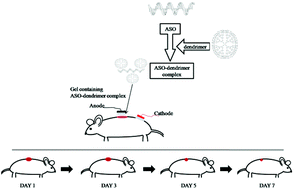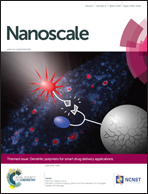Topical gene silencing by iontophoretic delivery of an antisense oligonucleotide–dendrimer nanocomplex: the proof of concept in a skin cancer mouse model†
Abstract
The study was aimed at investigating the feasibility of using a poly (amidoamine) (PAMAM) dendrimer as a carrier for topical iontophoretic delivery of an antisense oligonucleotide (ASO). Bcl-2, an anti-apoptotic protein implicated in skin cancer, was used as the model target protein to demonstrate the topical gene silencing approach. Confocal laser scanning microscopy studies demonstrated that the iontophoretically delivered ASO–dendrimer complex can reach the viable epidermis in porcine skin. In contrast, passively delivered free or dendrimer complexed ASO was mainly localized to the stratum corneum. The cell uptake of ASO was significantly enhanced by the dendrimer complex and the complex suppressed Bcl-2 levels in the cell. In the skin cancer mouse model, the iontophoretically delivered ASO–dendrimer complex reduced the tumor volume by 45% and was consistent with the reduction in Bcl-2 protein levels. The iontophoretically delivered ASO–dendrimer complex caused significant apoptosis in skin tumor. Overall, the findings from this study demonstrate that dendrimers are promising nanocarriers for developing topical gene silencing approaches for skin diseases.

- This article is part of the themed collection: Dendritic Polymers for Smart Drug Delivery Applications

 Please wait while we load your content...
Please wait while we load your content...